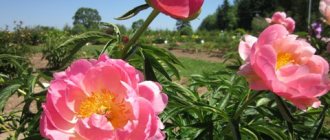Peonies are flowering herbaceous perennials with an ancient history. Today they can be found in almost every garden. Peonies are common throughout the world, but are especially highly valued in China. 2000 years ago, only members of the nobility could grow these flowers. Currently, festivals and exhibitions are organized in the Celestial Empire in honor of this unsurpassed plant. There are more than 5,000 varieties of peonies. One of the most beautiful is the Sarah Bernhardt variety. Peony Sarah Bernhardt is famous for its ease of care and incredibly beautiful delicate flowers of different shades.
Sarah Bernhardt is famous for her beauty and delicate aroma
Description of peony Sarah Bernhardt: photo and description, reviews
This unique variety appeared thanks to the efforts of the French breeder Pierre Louis Lemoine. The gallant Frenchman named his new creation in honor of the outstanding actress Sarah Bernhardt, whose beauty and talent the whole world admired. Wherever this peony is planted, it is always the center of attention, like an actor playing the main role on stage.
The plant is a herbaceous species with high decorative value. Large, beautiful flowers bloom on long, strong stems (about 1 m tall). The bushes look neat and retain their shape perfectly.
The leaves of the Sarah Bernhardt peony are also particularly decorative. Thanks to their openwork shape, they make the bush lush and unusual; with the arrival of cold weather, they do not turn yellow, but acquire an original purple color. The bushes do not require complex care, but they delight with long-lasting and very generous flowering.
Stems reach one meter
Attention! Peony milky-flowering Sarah Bernhardt grows well without support. It may only be required in windy weather.
The plant is light-loving and frost-resistant (up to - 40 ° C). It can grow in regions with different climates: from the central part of Russia to the Urals and Siberia. If the winter is mild, additional insulation is not required. Covering materials are used in severe frosts.
History of selection
Peony Sarah Bernhardt is of French origin. It owes its appearance to ornamental plant breeder Victor Lemoine, who specialized in hybridization. The variety was bred in 1906.
The flower received its name in honor of the actress Sarah Bernhardt, who, according to some sources, lived with Lemoine at one time. The famous Frenchwoman inspired many artists and photographers, which is why one of the most beautiful peonies deservedly bears her name.
Within a few years of its appearance, the Sarah Bernhardt peony came to Russia. He became interested in Lomonosov Moscow State University. There was a mistake when spreading the flower across the country; it was called Alex Fleming or Miss Eckhart. Both varieties actually exist, but appeared later. Their similarities lie in the size of the flowers and their pink, but brighter hue.
Breeders continue to work with the Sarah Bernhardt peony, obtaining new shades of flowers
Features of flowering
Sarah Bernhardt blooms late, when its fellows are already fading. The bush produces double or semi-double flowers with concave petals. Their main distinguishing feature is their impressive size (up to 20 cm in diameter). Most often there are specimens with soft pink petals edged with a thin silver stripe. White and red specimens were also bred.
You can admire the flowers for more than a month
They look very impressive and, when placed correctly, create an original contrast. You can admire their beauty for 30 to 45 days. The attention of others is immediately attracted to the lush hats of the most delicate shades. If flowering is too abundant, the stems may still need additional support.
Care after flowering and preparing the plant for cold weather
After flowering ends, caring for peonies does not stop. In order to enjoy lush, rich blooms next year, you need to properly prepare them for winter. First of all, all weeds are removed and the soil is thoroughly loosened. Faded buds are removed and the stems are trimmed. The operation is carried out quite low, leaving only small stumps.
At the end of September, the bushes are sprinkled with compost to protect them from the cold, and in more serious cases (when the winter is extremely severe), you can use spruce branches. Such shelter will be especially useful for young seedlings.
Peony varieties Sarah Bernhardt
Having received a unique plant, breeders try to develop several varieties of it. They all have different shades, but together they create a harmonious ensemble, striking in its brightness and beauty.
Peony Sarah Bernhardt Red
The Red Sarah Bernhardt peony rarely grows above 85 cm. The bright petals exude a subtle spicy aroma and look especially unusual against the backdrop of the deep tones of the leaves.
Terry variety with a wide range of shades: from pink to lilac and carmine
Peony Sarah Bernard White
White Sarah Bernhardt peony is used to create wedding arrangements. White petals with a lemon tint seem weightless and airy. Their diameter is only 15 cm, but they are distinguished by a variety of shapes (they can be spherical or resemble a rose) and have a silver border.
White Sarah Bernhardt is great for wedding bouquets
Peony Sarah Bernhardt Unique
The flowers resemble pink pearls that shimmer in the sun. Closer to the edge of the petals the shade becomes noticeably paler. There are also specimens with a purple tint. Peony Sarah Bernhardt Unique (pictured) looks equally impressive both in flower beds and as a cut flower.
Sarah Bernhardt's color is dominated by pastel shades
Peony Sarah Bernhardt Select
Gardeners' opinions about this variety vary: some consider it a separate variety, while others see similarities with Unique. This peony has not yet received wide distribution, so it is too early to talk about its characteristics.
This is Mr. X among the vast family of peonies
Use Cases
The magnificent old variety Sarah Bernhardt is used to create a wide variety of landscape compositions. It looks equally good in flower beds, alpine slides, in group and mono plantings, in ensembles with coniferous and perennial shrubs. Irises, lilies, bells, poppies, as well as thujas, barberry bushes, hellebore, honeysuckle, and decorative onions will make worthy company for this gorgeous plant. Sarah Bernhardt will attract the attention of guests, neighbors and passersby, being planted at the porch of a country house. It is quite possible to use cut flowers of this wonderful perennial, since they look very impressive in bouquets.
Application in design
Sarah Bernhardt peonies go well with many garden plants. It is better to match the “neighbors” in the flowerbed to the color, creating interesting contrasts. But flowers of approximately the same shades will merge into a “spot”. White Sarah Bernhardt peonies are usually combined with irises, sage, poppies, daylilies or bluebells. The deep beauty and mystery of red specimens will be highlighted by a well-groomed, smooth lawn. Pink peonies create complete harmony with thuja and barberry.
Peonies are combined with irises and poppies
Attention! You should not thicken the plantings, because Sarah Bernhardt peonies love free space and require periodic loosening.
The flower will not like the proximity of strongly growing plants. They will take away nutrients from the peony and block natural light.
Low peonies (45-60 cm) are suitable for growing on the balcony. However, the view can feel good on a bright and ventilated balcony if you create the most comfortable conditions for it.
Combination of peonies with other vegetation
Peonies are used to improve the appearance of garden plots, parks, greenhouses, etc. To obtain a chic composition, it is advisable to plant white flower varieties in combination with bright poppies, sage or irises. Flower bushes look good next to lush honeysuckle bushes. Flowers of bright colors can be combined with thuja or barberry bushes.
It should be noted that ants like to settle near peonies, which can lead to the death of not only the bush itself, but also nearby plantings. In order to prevent this, it is necessary to carry out pest prevention every spring and autumn.
As a preventative measure, it is recommended to use food traps for insects. Their essence is that the ants die when they eat them. But first they manage to bring the bait to the anthill. Thus, one pack of bait can provoke the death of an entire colony of ants.
The advantage of the bait is that it is not harmful to beneficial insects, such as earthworms, and does not lead to the death of pets.
Reproduction methods
There are three main methods:
- Seeds. They are collected from their own bushes, not fully ripe. Seed material is placed in open ground at the end of summer. At the first stage, they require warmth (from + 18 to + 28 ° C), and then the temperature should gradually decrease (to + 5-10 ° C). Plants may differ in characteristics from their parent specimens.
- By layering. This process is quite troublesome, so only experienced gardeners resort to it. The mother bush requires careful care so that shoots with roots form on it.
- By cuttings. The most effective and simple method. A healthy bush is dug up and cut off at a distance of about 10 cm from the root. Next, the roots are thoroughly washed and completely dried. Then they must be treated with potassium permanganate and kept in a Heteroauxin solution (at least 12 hours). Now you can plant the peony Sarah Bernhardt in the flowerbed.
Propagation by cuttings is the most effective method
Preventative treatments
Prevention is an integral part of plant care.
Pests
Of the insects, the most dangerous for peony bushes are aphids and nematodes, thrips and ants. As a preventive measure, in the spring the bushes are treated with insecticidal preparations such as Aktara or Aktellik. Also, fallen leaves and diseased plants are removed from the area in a timely manner.
Diseases
The diseases that most often affect plants include gray rot, ring spot and rust. As a preventative measure, in early spring the soil around peonies is sprayed with Bordeaux mixture. You can also use garlic infusion for processing.
Landing rules
The lifespan of Sarah Bernhardt peonies can reach 30 years or more. These plants require an ideal location. The first condition is a sufficient amount of soft diffused light. The second important point is the soil. The herbaceous peony Sarah Bernhardt feels best in slightly acidic soil with a high content of clay and sand.
Loose soil must be flavored with humus. Clay areas are dug up with the addition of sand. But swampy soils are absolutely not suitable.
In conditions of constant humidity, the roots of the plant will quickly die. The area must be cleared of weeds and fertilized.
Peonies should be planted in a well-lit place.
For planting, they usually choose self-harvested seedlings or those purchased from trusted nurseries. The best time is spring, when the thermometer will be stably at + 12 °C.
Sarah Bernhardt's peony planting scheme is very simple:
- Prepare a deep hole in advance so that a powerful root system can freely fit in it.
- Place drainage on the bottom and sprinkle it with organic fertilizer (loam + compost with a small amount of wood ash). Potash should be added to soil that is too acidic.
- The planting material is carefully placed in the hole and all the roots are straightened so that they lie freely in the ground. The buds are buried approximately 5 cm and carefully covered with earth. If the roots are too close or, conversely, far from the surface of the earth, the peony will not bloom.
- At the final stage, the bush is watered and the soil is mulched to conserve moisture.
If you plan to plant several bushes at once, be sure to leave a distance of at least 1 m between them.
Planting and caring for peony in open ground
In order for the bush to grow lush and not suffer from diseases, it is important to choose the right site for it and prepare it. There are no particular difficulties in further caring for peonies - regular watering, fertilizing, preventive treatments - that's all the plant needs.
Preparation of the site and planting material
Peonies are light-loving plants, so shaded areas are not suitable for planting them, as the bushes will not be able to fully develop there. Light partial shade in the middle of the day is allowed; it will protect the petals from the scorching rays of the sun.
It is not recommended to choose swampy areas for planting peonies; excessive humidity leads to rotting of the root system and the development of fungal diseases. Soil with clay and sand is preferable; it should have a slightly acidic reaction. It is recommended to add a little organic matter to loose soil to improve its characteristics, for example, humus.
When planting bushes, take into account that the distance between them should be at least 100 cm, since, as the peonies grow, they will begin to deprive each other of food. The distance from fences and walls of buildings is about 1 meter; this is necessary so that rainwater from the roofs does not damage the flower petals.
Purchase planting material only from certified retail outlets to avoid variety mismatch. Before planting, the roots of the flower are soaked in a highly concentrated solution of potassium permanganate for half an hour, then dried and sprinkled with wood ash.
Peony planting dates and patterns
It is recommended to plant peonies either at the end of summer or at the beginning of autumn; over the winter, the rhizomes adapt to a new place, and in the spring they will begin active growth.
Planting work is carried out according to the following algorithm:
- Dig holes about 80 cm deep, and lay a thin layer of sand drainage on the bottom.
- Organic fertilizer is placed on top of the sand.
- Bushes are placed on this layer, deepening the buds by 5 cm.
- Cover with remaining soil and irrigate.
- It is recommended to mulch the soil around the peonies so that the bushes can better withstand the winter.
See also
Description of varieties of perennial delphinium, planting and care in open ground
Read
Feeding and watering
Nutrient components begin to be added in the second year after planting. Next, fertilize the plants three times per season:
- For the first time, complex mineral fertilizer is used.
- The second time, when the buds are forming, the peonies are fed with diluted bird droppings.
- With the arrival of autumn, superphosphate diluted in water is added.
Drying out the soil around peonies negatively affects the formation of buds, but excessive moisture is also harmful to plants. Watering is carried out with settled water approximately once every 7 days. About 3 buckets of water are consumed per specimen.
Loosening, mulching the soil
After each irrigation, the soil around the peonies is carefully loosened so as not to damage the root system. At the same time, they get rid of weeds so that they do not take away nutrients from the crops. Experienced gardeners mulch the tree trunk circle, then there is no need for regular weeding.
Shelter from drafts
To prevent peony bushes from breaking under the pressure of the wind, tall shrubs are planted nearby or plants are placed near the walls of buildings and fences.
Trimming
Leaves are pruned in the fall in preparation for winter. If this is not done, pathogens and insects will settle in the foliage. The stems are shortened almost to ground level, this will make it more convenient to cover the plants for the winter.
Transfer
If it is necessary to move the peony bush to a new place, carefully dig it up from all sides. After this, they are loosened with a pitchfork and turned out of the ground. Wash off all the soil from the roots and leave the bush for 6-8 hours in the open air. After this, they plant it in a new place and water it abundantly. They do transplantation only in August.
Preparing for winter
In regions with cold winters, peonies of this variety need additional shelter. After pruning and the last application of fertilizer, a layer of mulch made from organic materials is laid on top. In the Urals and Siberia, it is recommended to cover it with additional lutrasil to protect the kidneys from freezing.
Aftercare
Peony Sarah Bernhardt is an unpretentious plant. When setting buds, it is necessary to moisten the soil every 7 days, the rest of the time - less often. You can choose the right watering mode experimentally, taking into account the condition of the soil. Sarah Bernhardt peonies do not like drought or waterlogging. Each bush receives 3 to 4 buckets of water at a time.
Peonies require regular watering and feeding
According to reviews of the Red Sarah Bernard peony and other varieties of the variety, if all planting rules are followed, the first few years of feeding will not be required. Over time, fertilizers are applied only three times throughout the year. In the fall, superphosphate is used, in the summer, a solution based on bird droppings is used, and in the spring, it is enough to carry out the mulching procedure.
You also need to regularly weed the soil around the bushes and promptly remove dried flowers, otherwise they will cause the development of diseases.
Diseases
Milky-flowered peonies are rare, but still suffer from various diseases. Most often this is:
- Gray rot. A fungal disease that leads to the formation of a gray coating on young plants. The disease cannot be treated; its occurrence can only be prevented by treating the bushes with garlic solution after the snow melts.
- Rust. A pathology of fungal origin, causing the appearance of brown spots on the green part of the bush. When symptoms appear, it is necessary to remove all affected parts of the bush.
- Mosaic. An anomaly leading to the appearance of light green spots on the leaves. There is no treatment. To prevent the spread of the disease throughout the area, diseased bushes must be dug up and burned.
Diseases, if timely measures are not taken, will lead to the rapid death of the plant.
What to do to protect peonies from diseases? To prevent plants from being subject to pathological conditions, they must be properly and promptly cared for. You should monitor the cleanliness of the area and the amount of moisture in the soil. Dense plantings, excess moisture and pollution are the main causes of fungal diseases.
Growing problems: lack of flowering
The flowering of fragrant peonies is influenced by a lot of factors. The most common are:
- Unsuitable soil. In order for a beautiful flower to begin forming buds, it is necessary to transplant it to a more suitable area.
- Planting a seedling with an undeveloped root system. To solve the problem, the plant should be dug out of the ground, rooted in a dark place and replanted.
- Frequent transfers. You can replant the plant or divide the root system no more often than once every 5 years. More frequent interventions will lead to weakening of the flower and lack of flowering.
- Untimely transplant. Mature bushes that grow in one place for a long time need to be replanted, otherwise they stop forming buds. Replantation should be done every 5-10 years.
- Lack of potassium fertilizers.
- The presence of insects eating the root system.
- Irrigation system failure.
- Presence of diseases.
Knowing why a flower bush does not bloom, you can correct the problems and return the plant to its former decorative appearance. Peony Sarah Bernhardt white more often faces the problem of lack of flowering than other varieties of flowers.
Peony is easy to care for, despite possible problems in growing. Regular care and timely manipulation will help preserve the decorative appearance of the flower for 30 years or more.
Diseases, pests and ways to combat them
The Sarah Bernhardt variety has good immunity to many diseases typical of peonies. Sometimes a flower may develop rust, gray rot or mosaic. Among the pests that can be dangerous are bronze beetles, aphids, and ants. They are saved from with folk remedies and insecticidal preparations. Any problems are the result of errors in planting or care, so the best prevention is to follow agricultural practices.
Thanks to the rich palette of shades of Sarah Bernhardt peony varieties, the flower is very popular among gardeners. He is able to decorate any area with his lush baskets, turning it into a fairy-tale corner.
Feeding and fertilizers
Sarah Bernhardt peonies must be fed.
For the harmonious growth and development of plants, feeding peonies is of great importance. Mineral fertilizers applied to the planting hole will provide the plant with all the necessary nutrients for the next 3-4 years. Later they need to be fed from time to time.
For optimal development of the root system, potassium-phosphorus fertilizers will be required, and nitrogen fertilizers will be required for active bud formation.
The peony variety Sarah Bernhardt requires 3-stage feeding in the spring-summer period:
- The first is carried out in early spring, when there is still snow. A mixture of urea and potassium sulfate in a ratio of 15 g x 15 g is scattered around the circumference of the bush.
- The second one is needed for planting flowers. For these purposes, a solution of 10 g of urea, 15 g of potassium sulfate and 20 g of superphosphate is used.
- The third and final fertilizing is done at the end of flowering to stimulate bud growth. The composition includes potassium and phosphorus fertilizers in equal proportions (15 g each).
You cannot fertilize when the soil is dry: this can cause burns to the root system and further death of the plant. Manipulations are carried out only after watering or rain.











